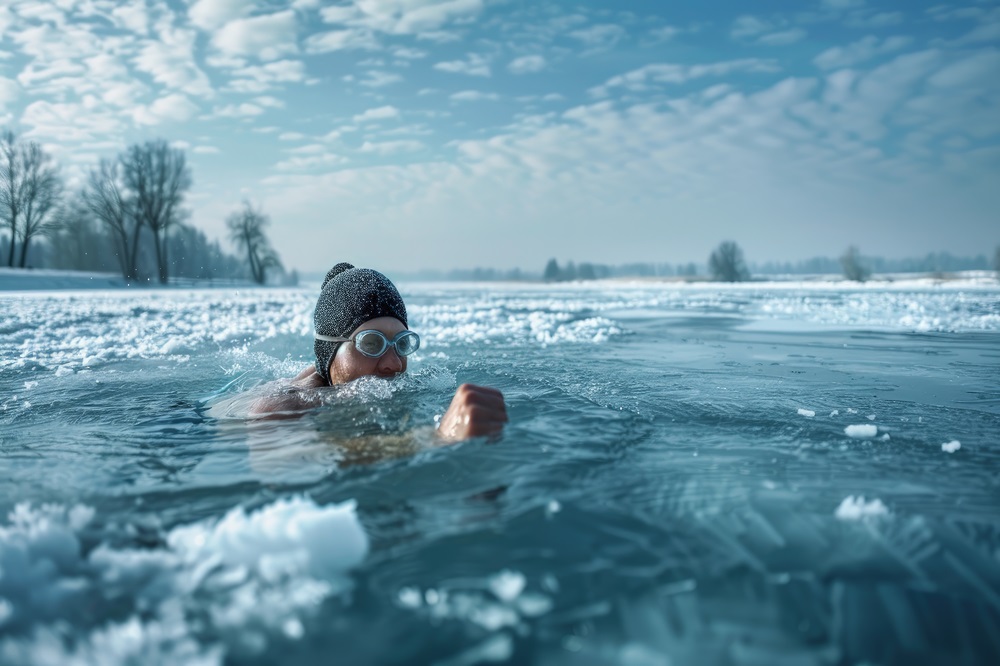Ice bathing – what is it and how to start? A complete guide

Ice bathing, also known as winter swimming, is a form of outdoor recreation that has been gaining popularity worldwide. Practiced in open bodies of water, it may bring multiple health benefits, such as boosting immunity or supporting recovery from muscle and joint pain. What exactly is ice bathing? How should you prepare? Cold water immersion effects - what can it cause? ice bathing contraindications - who should avoid plunging into icy water?
Table of contents
- What is ice bathing?
- Is ice bathing healthy? Benefits of winter swimming
- Ice bathing - side effects and risks
- Contraindications to ice bathing
- Ice bathing and hypertension
- Ice bathing and varicose veins
- How to start ice bathing? Practical tips for beginners
- Ice bathing for children - is it safe?
- Ice bathing during pregnancy - what you should know
- Ice bathing in the sea - what to know
- Recommended supplements for cold water swimmers
What is ice bathing?
Ice bathing involves briefly immersing or bathing in water colder than 59°F (15°C). It is usually practiced in lakes, rivers, or the sea from early autumn through late spring, most often in groups.
This practice, rooted in ancient traditions, was first documented around 2500 BC. Cold baths were known in Ancient Egypt, while Romans incorporated them into public baths. In 400 BC, Hippocrates recommended cold water immersion as a remedy for certain ailments, and in modern times it has been used as part of hydrotherapy. In Poland, the first association of winter swimming enthusiasts was established in 1975. In the 21st century, it has become increasingly popular in the Baltic states, Russia, and Scandinavia.
With the rise of healthy lifestyles and wellness practices, ice bathing attracts people around the globe regardless of age, fitness level, or daily activity.
Is ice bathing healthy? Benefits of winter swimming
“Benefits of ice bathing” is a topic that interests not only beginners but also scientists and researchers.
Studies show that it can strengthen the immune system by stimulating the production of leukocytes and monocytes. Regular immersion helps the body adapt to cold, improves cold tolerance, and may reduce the risk of infections. It can also benefit cardiovascular function by lowering blood pressure and improving circulation through alternating constriction and dilation of blood vessels.
Cold baths may also improve skin circulation, elasticity, and firmness, which can enhance skin appearance and reduce wrinkles or cellulite. Ice bathing has been linked to reduced pain and inflammation, faster recovery, and improved insulin sensitivity. Moreover, it can trigger endorphin release, lower stress, increase energy, improve mood, enhance sleep quality, and support weight loss.
Overcoming the challenge of stepping out of one’s comfort zone can also build mental resilience and self-confidence. Some studies suggest it may enhance memory and concentration. Early findings indicate potential benefits in certain neurodegenerative and mental health conditions, though more research is needed.
Ice bathing - side effects and risks
Despite its potential health benefits, ice bathing also carries risks, especially without proper preparation.
The body needs gradual adaptation. Sudden immersion without preparation can trigger thermal shock, placing excessive stress on the body. For beginners, swimming should always be done in the company of others for safety.
Exposure to cold water may cause blood vessel constriction and centralization of circulation, increasing strain on the cardiovascular system and potentially triggering arrhythmias. The initial response often includes increased heart rate, vessel constriction, and higher blood pressure, which can be dangerous for people with ischemic heart disease and may lead to dizziness or fainting.
Risks also include hypothermia, frostbite, and uncontrolled hyperventilation, which can reduce oxygen supply to the brain. In rare cases, severe allergic reactions may occur, causing redness, itching, or swelling of the skin.
To minimize risks, one should gradually immerse the body, stay calm, and follow safety guidelines when entering cold water.
Contraindications to ice bathing
Cold immersion puts significant stress on the body, especially for people with cardiovascular issues. It is not recommended for those with arrhythmias, ischemic heart disease, or valve disorders. Contraindications also include a history of heart attack, coronary artery disease, and uncontrolled hypertension.
It is unsafe for people with epilepsy, neurological conditions, asthma, or respiratory diseases. It is also not recommended for those with hypothyroidism, Lyme disease, kidney disorders, fever, or Raynaud’s disease.
Anyone with such conditions should consult a doctor before trying ice bathing to assess risks and precautions.
Ice bathing and hypertension
For individuals with uncontrolled hypertension, immersion in icy water can be dangerous. Sudden contact with cold water may cause vessel constriction and raise blood pressure, while rapid temperature changes can trigger arrhythmias and increase the risk of heart attack.
However, some studies suggest that people with controlled hypertension under medical supervision may benefit from ice bathing. It could help lower blood pressure, reduce stress, improve mood, and lower long-term cardiovascular risk.
Therefore, anyone with hypertension should consult their physician before starting this activity.
Ice bathing and varicose veins
A common question is whether varicose veins prevent people from practicing winter swimming. Research indicates that brief cold exposure may actually support venous health. Low temperatures constrict veins, reduce blood pooling, relieve vessel walls, and may help reduce swelling.
Still, individuals with varicose veins should consult their doctor before starting, to ensure no contraindications apply.
How to start ice bathing? Practical tips for beginners
Safe winter swimming requires preparation and adaptation. First, consult your doctor to rule out contraindications. Then gradually get used to the cold — start with cold showers or wading in cool water before attempting full immersion.
Beginners should start in autumn when water temperatures are not yet extremely low, and keep initial sessions short. Stay in the water for only 5–15 minutes, while experienced swimmers may last up to 30 minutes.
Proper gear is essential. Wear a hat to prevent heat loss, and consider gloves and neoprene shoes to protect your hands and feet. Sturdy sandals or water shoes with thick soles are also recommended.
Always warm up with light exercises before entering the water. Once inside, focus on calm, steady breathing and staying relaxed.
After leaving the water, dry off and dress warmly as quickly as possible, and have a hot drink or soup. Avoid alcohol and intense physical activity right before or after immersion.
The benefits can be felt immediately — many people experience a rush of endorphins, reduced stress, and increased confidence after just one session.
Ice bathing for children - is it safe?
Parents often wonder if children can safely practice winter swimming. Research suggests that it can be safe, but extra caution is needed for kids under 3, who lack sufficient fat tissue and may cool down dangerously fast.
Always consult a pediatrician before introducing a child to cold water. Children should spend far less time in the water than adults — for toddlers, a few seconds is enough, while school-aged children should stay no longer than 2 minutes. Always closely monitor their reactions and never leave them unsupervised.
Ice bathing during pregnancy - what you should know
Ice bathing while pregnant is a controversial topic. Some argue it’s risky, while others point to its potential benefits.
According to gynecologists, women who practiced cold immersion before pregnancy may continue during pregnancy, as short exposure should not significantly lower body temperature or harm the baby.
However, women who have never practiced winter swimming should not start during pregnancy, as cold shock, increased heart rate, hyperventilation, and higher blood pressure could pose risks to the fetus.
Ice bathing in the sea - what to know
Swimming in the sea is a special challenge due to waves and currents.
Always enter only in safe, accessible locations with solid footing, and stay where you can touch the bottom. Never swim out into deep water.
Sea water temperatures are usually lower than in lakes or rivers, making it an even more extreme form of cold exposure.
For safety, it’s best to prepare beforehand by practicing cold immersion at home in a bathtub or barrel.
Recommended supplements for cold water swimmers
Regular winter swimming can support immunity, endurance, and overall well-being. However, frequent cold exposure may increase nutritional needs, so supplements can be helpful. Examples include:
- OstroVit Vitamin D3 - supports immune health and bone strength
- OstroVit Omega 3 - a concentrated source of essential fatty acids for heart and circulation
- OstroVit Collagen - helps joint and skin recovery after cold exposure
- OstroVit Glucosamine - supports joint health during frequent sessions in cold water

